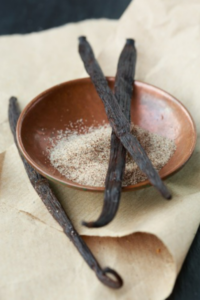A Little Bit Vanilla
go.ncsu.edu/readext?832455
en Español / em Português
El inglés es el idioma de control de esta página. En la medida en que haya algún conflicto entre la traducción al inglés y la traducción, el inglés prevalece.
Al hacer clic en el enlace de traducción se activa un servicio de traducción gratuito para convertir la página al español. Al igual que con cualquier traducción por Internet, la conversión no es sensible al contexto y puede que no traduzca el texto en su significado original. NC State Extension no garantiza la exactitud del texto traducido. Por favor, tenga en cuenta que algunas aplicaciones y/o servicios pueden no funcionar como se espera cuando se traducen.
Português
Inglês é o idioma de controle desta página. Na medida que haja algum conflito entre o texto original em Inglês e a tradução, o Inglês prevalece.
Ao clicar no link de tradução, um serviço gratuito de tradução será ativado para converter a página para o Português. Como em qualquer tradução pela internet, a conversão não é sensivel ao contexto e pode não ocorrer a tradução para o significado orginal. O serviço de Extensão da Carolina do Norte (NC State Extension) não garante a exatidão do texto traduzido. Por favor, observe que algumas funções ou serviços podem não funcionar como esperado após a tradução.
English
English is the controlling language of this page. To the extent there is any conflict between the English text and the translation, English controls.
Clicking on the translation link activates a free translation service to convert the page to Spanish. As with any Internet translation, the conversion is not context-sensitive and may not translate the text to its original meaning. NC State Extension does not guarantee the accuracy of the translated text. Please note that some applications and/or services may not function as expected when translated.
Collapse ▲Cultivated in hot climates with high heat and high humidity, vanilla is second only to saffron in terms of spice value. Like saffron, the harvesting of vanilla is manual and labor intensive. The vanilla flower opens just one day every year, and is pollinated by just one species of bee. The vanilla bean is so picky that when cultivated in greenhouses in foreign lands, it would not produce a single bean without its beloved Melipona bee.
However, in 1841, a young boy discovered a precise and painstaking technic of hand pollinating the flowers. So successful was the process that nearly all commercially produced vanilla to this day is hand pollinated. It bears repeating, since every flower only yields one bean, that almost every bean on the market today was pollinated by hand.
It should come as no surprise that vanilla production in no way meets vanilla demand. With an estimated yearly production of approximately 2,000 metric tons, vanilla substitute is conversely produced to the tune of 20,000 metric tons annually. Remarkably complex, vanilla was not used as anything but an additive (mainly for chocolate) until the early 1600’s when Queen Elizabeth I fell in love with a candy her apothecary created using, as the saying goes, plain vanilla.
Today, the price for natural vanilla is around $300.00 a pound. Saffron, for comparison, starts at around $500.00 a pound, and Burgundy Black Truffles are currently averaging $400.00 a pound. The Sustainable Vanilla Initiative was launched in 2015 in an effort to promote “the long-term stable supply of high-quality, natural vanilla that is produced in a socially, environmentally, and economically sustainable way.” An important initiative for an ingredient found in over 18,000 products on the market today, Queen Elizabeth the I would be pleased.





